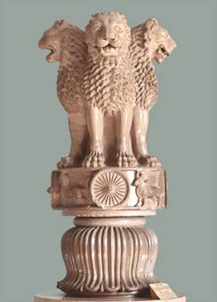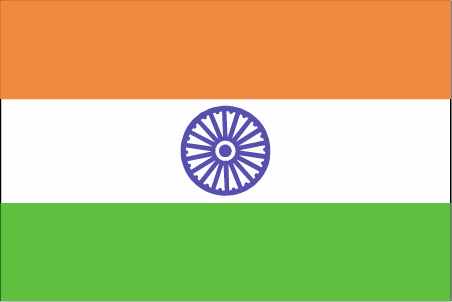
Introduction |
Geography |
History |
Communication |
Beliefs |
Society |
Economy |
Government |
Technology |
Links to Other Websites |
 |
 |
 |
Government |
The Flag of India
India’s flag is a horizontal tricolor in three equal proportions.
The top is saffron or orange. It symbolizes courage, sacrifice, and the spirit of renunciation.
The middle is white symbolizing purity and truth.
The bottom is dark green which stands for faith and fertility of the earth on which all life depends.
In the middle white band is a dark blue wheel with 24 spokes. It is called the wheel of Asoka, an important ruler in India’s history. It is also referred to as the Dharmachakra, a Buddhist symbol dating back to ancient times.
The National Emblem of India
This is a replica of the Lion of Sarnath, the capital or top part of Asoka’s Pillar which he had built at the place where Buddha first taught. The original statue has four lions resting on an abacus with four smaller animals representing the four directions: a lion for the north, an elephant for east, a horse for south, and a bull for west. This in turn rests on a blooming lotus.
The emblem has only three lions standing back to back which symbolize courage, strength, and confidence. They rest on an abacus with a bull and a horse separated by the chakra wheel.
This emblem is part of the official letterhead of the government of India and is on all Indian currency and the national passport as well.
Government means rule by a person or group of people. From earliest times, humans have looked to the strongest or wisest person in the group to guide them. Sometimes that meant spiritual guidance and a shaman or priest was the leader. Sometimes that meant needing the wisdom of the oldest person and an elder would become leader. Sometimes the strongest or most successful hunter would be the leader.
As hunters and gatherers settled into farming communities, as these villages grew larger, as groups of people began trading with others outside their own groups, leaders were needed who could guide and control the spiritual, economic, and social aspects of the group. Often a group of men from the tribe or clan made decisions together with a spiritual leader who was in charge. It wasn’t until farming communities became cities that extensive leadership was needed and chieftains or kings ruled.
Throughout its more than 5,000 year history, many individuals and groups have ruled India. In the time of the Indus River Valley civilization evidence from their seals shows that there may have been a priest-king who was the ruler of each separate city. This may have been the Raja or chieftain, as they were called in later times, and they may have had councils called Sabha and Samiti. All of these are Indian names still used in many places today which date back to ancient times.
Below are the names of some of the types of leaders in India throughout the many years of its history. You will also find the names of some famous rulers. After you have explored the section on Government in the Learning Centers, write List A in your Social Studies notebook. Put the names of the rulers who best match the type of leadership on the line next to it. Remember there may be more than one famous name for the type of ruler. You may find the informaton on the History page helpful.
List A: Types of Rulers
|
List B: Names of Famous Rulers Akbar
|